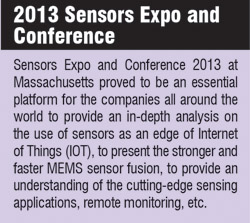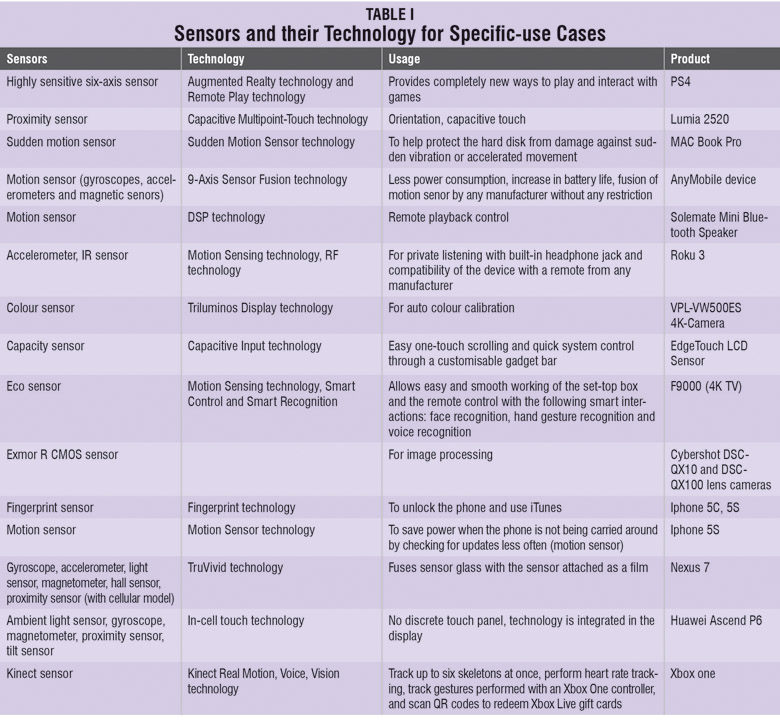Availability of standalone sensor evaluation boards as commercial off-the-shelf units have immensely helped design engineers integrate the same in their designs at prototyping/proof-of-concept stage and design products with use cases that were never thought of earlier. “One of the biggest gainers of such sensors is wearable computing category—smart watch, wrist bands for health and wellness, sports performance monitoring, etc. And, sensor providers publish APIs/trainings that enable designers adapt to a particular sensor quickly,” says Dhaval Vasa, project manager at eInfoChips.
immensely helped design engineers integrate the same in their designs at prototyping/proof-of-concept stage and design products with use cases that were never thought of earlier. “One of the biggest gainers of such sensors is wearable computing category—smart watch, wrist bands for health and wellness, sports performance monitoring, etc. And, sensor providers publish APIs/trainings that enable designers adapt to a particular sensor quickly,” says Dhaval Vasa, project manager at eInfoChips.
Some sensor-based kits and modules available with their price list are listed in Table II.
Apart from these modules, there are some development tools of popular brands, based on some particular types of sensors, that can act as a learning source for the young engineers and also help them in various innovations.
How to select a sensor for your application
A sensor should be selected depending on the application in mind. Sensors are of two types: limit detector and qualitative and quantitative analysis measuring element. “Limit detection type of sensor gives out logic 1 or 0. This operates as a watchdog in the system and annunciates in fast response at occurrence of monitored parameter. Specifically, this could be an active element used for a particular purpose as a feedback circuit in a power supply, or a Hall effect switch detecting the presence of magnetic field of rated magnetic flux and direction. The other example is a PIR detector detecting presence of an object and movement of the same. Qualitative and quantitative analysis type of sensor could do the job rather slowly and deliver its response in a required electrical form,” explains P. Chow Reddy, R&D manager, Power Division, ICOMM Tele Ltd.
There are certain things which a designer has to ensure so that his product does not fail due to a faulty selection of the sensor involved.
Identifying the sensing parameter. The parameter could be in any form such as voltage, current, frequency, temperature, pressure, light, touch, presence, sound and chemical reaction to name a few. Any of these needs to be converted to electrical form for electronic analysis. “A thermistor varies its resistance depending on the thermal stress over it. Thermistor as an element in a potential divider circuit results out a temperature corresponding to the potential across it. An engineer working on this needs to analyse the range of operation of thermistor, way to get safe operating range of the sensor, observe the performance of the thermistor to see what time it takes to convert the parameter, and the linearity and response of the sensor for the physical changes occurring across it,” explains Chow Reddy.

Dhaval Vasa gives us advice on the considerations to be made whilst selecting an IR sensor for sensing the proximity of objects. “If you take an example of a proximity sensor (IR-based), which emits an electromagnetic field or a beam of electromagnetic radiation, and looks for changes in the field or return signal, one essentially needs to carefully consider the ‘sensing frequency’ at which sensing data is provided, ‘range’ that gets covered in form of angle/distance with ‘resolution’, ‘size’ depending on the device on which such a proximity sensor will be mounted, and operating environment/conditions under which such a sensor will function.” Such a sensor can have high reliability and long functional life due to absence of mechanical parts and lack of physical contact between the sensor and the object.
Reliability. Ensuring a robust design with maintenance-free packaging is very important. This is because sensors are that part of the device which mostly comes into contact with the world, and hence has to have the ability to withstand harsh environment without losing on performance. Sahil Khan, embedded systems consultant at Upheave Systems Pvt Ltd, adds that, “We have seen soil moisture sensors losing accuracy in saline agricultural soils. With huge requirements for the IoT, maintenance is a big no-no for a sensing node.” A sensor must be able to transduce information reliably over and over again, and that too within reasonable accuracy.
Easy integration. For the developer’s perspective, using ADC, employing filtering equations, extracting data and then calibrating the firmware is troublesome. This is why, to reduce design effort, pre-calibrated sensors which support common interfaces like TWI/I2C or SWI, SPI, etc are preferable.
A common example is the use of NTC or PTC thermistors versus a DHT11 sensor to read temperature and humidity data. “DHT11 temperature and humidity sensor features a temperature and humidity sensor complex with a calibrated digital signal output. By using the exclusive digital signal acquisition technique and temperature and humidity sensing technology, it ensures high reliability and excellent long-term stability. This sensor includes a resistive-type humidity measurement component and an NTC temperature measurement component, and connects to a high-performance 8-bit microcontroller, offering excellent quality, fast response, anti-interference ability and cost-effectiveness,” explains Sahil.






